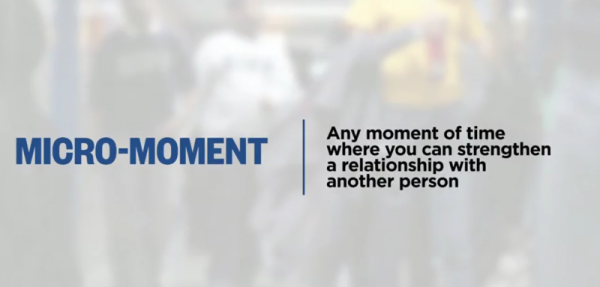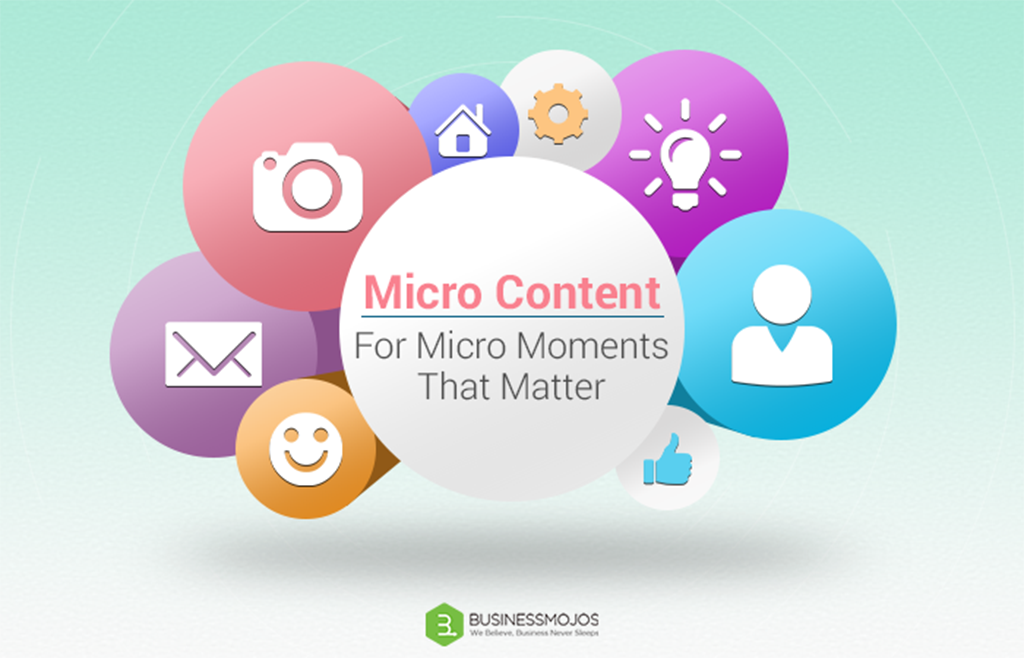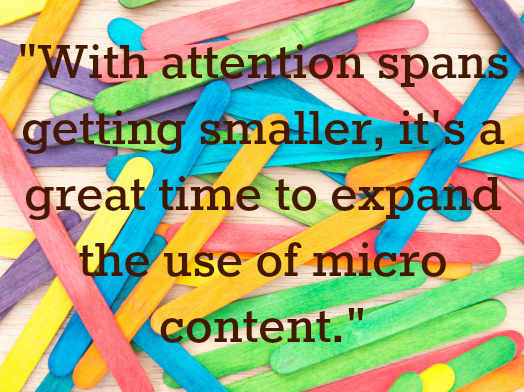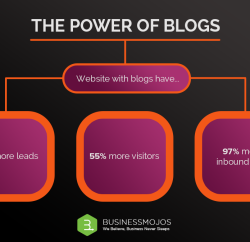B2B World works in hyper-speed now, new ventures powered by zealous digital native millennials are touching billion dollar valuations. So, lead gen teams, marketing and sales division need to adapt to the buyers’ psychology.
A 1300 word article about micro content, ironically that’s the way bloggers go micro. SEO stats tell us to write really big articles to get max social shares and backlinks, I hope you get my conundrum 🙂
I have used Micro content multiple times, you may be asking, what the heck is it?
Micro content is a short content optimized for social media (FB, Twitter, Tumbler, Snapchat etc.) like videos, Gifs, animated graphics and posters.
For example:
- Sending a photo of hand written thank you note to your prospect after your first meeting via LinkedIn direct message or email.
- Sharing a 1 minute client testimonial video presentation via LinkedIn, Slack or Twitter Direct Message.
- Try sending GIF Infographics to tell your brand story and what you may offer to a prospect
- Putting short excerpts of your content in magazine apps like LinkedIn Pulse and Flipboard, etc.
Researches of McEwan University, Canada, conducted on 2000 participants revealed that attention span of a digitally active individual has dropped to 8 seconds, which is 12 seconds lesser than in the year 2000.
Whopping data processing speed combined with faster internet connectivity has made ‘customer impatience’ fashionable. All this has contributed to an overload of content put up for consumption. Decision makers are bombarded with tons of content every day but they get little time to absorb it.
Though whitepapers, eBooks, 1500 word blogs are going to trigger B2B purchase decision in the future, micro content will also have a big part to play. This shift to short content has made marketers to consider importance of context in conversations.
Typical new gen B2B decision makers need context-relevant content, that is at the same time short and rich, to quench their curiosity. Tech savvy generation loves hyper-speed content consumption; that’s why 25% online content is viewed for less than 4 seconds, according to The Department of Informatics at University of Hamburg.
This answers why micro marketing materials like Vine videos, Snapchat snaps, Instagram pics are all a hype now.
Content that triggers action needs to be put up for prospects to consume. Thus, prompting targets to take action pushed by contextually right messages. These micro moments that trigger action are vital.
So, B2B micro moments such as:
- I wanna know about it
- I wanna demo it
- I wanna try it
- I wanna buy it
Needs special short and precise sticky content so as to educate, empower and move your customers in each of the above micro moments. These are some questions which should help you set the ‘micro content’ ball rolling.
So, do you think you can market like its 2008 in 2015?
Your targets swipe, pinch and slide all your content, swiftly. Such a time calls for effective micro moment marketing. Buying is an emotionally packed logical process; more now than ever before.
The reason why:
The B2B buyers feel a need to be empowered but in their own time and terms. That’s why, you can’t send big eBooks of 40 pages to inspire an interaction especially with mobile savvy generation at the helm of companies.
DellCares’ case study will elaborate my point:
Case Study:
Dell wanted to be where the customer was so it started @DellCares initiative. This was an extension of customer listening effort. They tried to provide support and real time response to customer queries and concerns. This digital engagement involved responses through Tweet, Facebook post/chat or instant chat, etc. DellCares reduced the time spent by customer on agent assisted troubleshooting.
Thus, social media support effort garnered positive sentiments from about 85% customers having an initial negative opinion. As a consequence, brand value amplified and an extra $265,000 weekly revenue was raked by Dell. Watch_Video
What are marketers doing wrong?
We are still stuck in the email campaign era, when we can’t expect even 1 percent of favorable response from it. Still hundreds of hours of a marketer’s life is put to sub-optimal use by focusing on email marketing.
This being the case, biggest disruptive channel decision makers use to gather knowledge is mobile and social media. That makes this knowledge exchange not bound by the materials your marketing team send out. It depends on the digression and free time a prospect has. Thus, social selling, cross channel presence and mobile friendliness becomes vital.
Case Study:
When orthodox telemarketing and email outreach program lacked the charm to sell IBM’s cloud services, they rolled out an initiative called ‘intelligent listening’ via social media. Primarily they wanted to be in the avenues where conversations on cloud were happening. Secondarily, they wanted to know the hot button topics users care about. Lastly they wanted to know where the industry was heading by observing trends and problems of stakeholders in the industry.
Sales reps used this initiative to contribute value to industry discussions by giving answers and resources to resolve problems behind relevant discussion threads. This effort provided 10 orders on the first day and a 4x hike in quarterly orders compared to the previous year.
How important is understanding the context of a visit for a marketer?
Facebook visit is vastly different from a Twitter or LinkedIn visit. People visit Facebook to casually meet old friends or see what’s happening in one’s circle. LinkedIn is for connecting professionally with leads, clients, old colleagues and seniors. So, psychology of each user’s visit needs to be understood to deliver great messaging.
Intention based marketing makes your potentials hear more from you. Map out each prospects point in the customer journey and produce compulsive content that resonates with the mood, channel or intention of a customer.
What strategies does the lean marketing team use to influence decision makers in various stages of the buying funnel?
Content consumption has changed a lot. Now a days, decision makers prefer peer to peer reviews, micro influenced opinions, industry influenced opinion, etc. This being the case, high flying marketing teams use pin pointed micro content to influence buyers. This happens when your prospect is empowered by:
- Providing collateral on product or services, mentioning their unique value proposition.
- Making it easy for prospects to find customer reviews
- Focusing company’s social media engagement to build and manage relationship with prospects
- Providing content that plays a strong facilitating role in decision making
How can you consistently be on your prospects mind using micro content?
- Be Interesting: Use cartoons, animated videos, quotes, illustrations to provide focused snippets of information to your prospect. Make and test micro content pieces.
- Be actionable: Go for pint sized content with clearly laid out ‘CTA’ and specific goals. Set only a specific goal for each piece of micro content.
- Be Visible: Setup a specific brand language and standardize your message attributes like colors used, language used, etc. Make yourself and your brand easily identifiable.
- Be Regular: Setup a schedule by virtue of which your prospects start expecting updates from you regularly.
- Be present across channels: Be present in all the channels your prospect uses. Convergence of all your marketing efforts should be ‘to make life simple for your customer’.
- Design and distribute cool content: Make sure you create content at least a week in advance. Each point in the funnel should have a particular short-form marketing copy. Schedule using mobile and social media scheduling apps. Understand when you’re most likely to interact with your content.
- Make the whole-thing-easy: Your prospects or readers should find it easy to opt-in and opt-out for a newsletter or updates. Allow them to tweet, snap or post specific areas in your marketing copy.
- Be original: Invest some brainstorming time and find ideas on content pieces. Use photos, memes, Vines, idea cue cards, etc.
3 Easy Ways To Make Micro Content
Reduce, Reuse or Repost
- Reduce: Reduce white paper into eBooks, eBooks into blogs, blogs into podcasts, quotes and snippets. Make webinar responses for video blogs.
- Reuse: Use your old social media post such as animated videos, snippet cards, slides, sound bites, and memes.
- Repost: Post custom material configured for each platform. Try re-posting to different target geographies, decision makers and on to industry sub categories hashtags.






